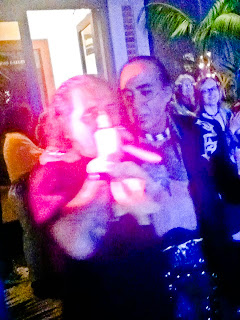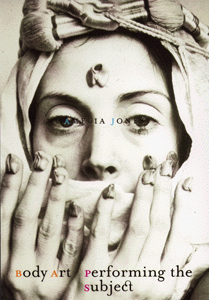The Occult Activism of 1960s Group WITCH is Still Relevant
This article popped up on the feed the other day, and I was reminded about the presence of and representation of witches throughout time, in a society that has pretty much commodified witchcraft into a visual and figurative only culture, i.e. Halloween, rather than a metaphoric one. The W.I.T.C.H. group was collective performance, an agitation and ripple to the world of conventionality. They aligned their ideals through direct actions, mailings, printed matter, and spoken activism. Like many other political aggregates of the time, we are fortunate to have propaganda ephemera validating action and disruption:

W.I.T.C.H. Women’s Liberation [Women’s International Terrorist Conspiracy from Hell], c. 1969, mailing list card [#9011]
”
Highly Strung, a large-scale piece of puppetry directed by Dave Jones. See some behind-the-scenes stuff at Dave’s blog.

Los Doppelgängers Fun, Frolic, Convergence
Michael Sedano
Richard Montoya and Guillermo Gómez-Peña, Los Doppelgängers. What a bill for an evening's entertainment. Two geniuses, one certified one not. Ni modo, it is a dream bill.
A Mexicano and a Chicano, the two performers don't look alike; each is a spitting image of himself. Ricardo is not William nor is Guillermo Richard, so they're not tocayos. The one adheres to unscripted spontaneity the other a playwright, by nature dedicated to structure and plot. So what is the doppel part of this gang, and what are the two of them doing sharing the same stage at UCLA's Fowler Museum?
 Richard Montoya, Guillermo Gómez-Peña
Richard Montoya, Guillermo Gómez-Peña
To believe the program, the collaboration offers "mana a mana" performance around border issues. The pair will perform reworked excerpts from older work. The promised result both a ‘profane’ border ritual and a ‘living archive’ that explores the rampant violence taking place in Mexico and the concurrent anti-immigration hysteria in the United States.
Guillermo Gómez-Peña, for one, explains some of the above, offering his willingness to see what would happen. Take it Montoya. Richard Montoya puts down his chain saw to flash the pages of a script for the evening then admits he has little idea what will actually take place in this space. Montoya apologizes for the placement of the massive stone fountain smack aplastada in the center of the room. It’s on loan to be returned to the Getty Villa tomorrow. He lied; I learned the fountain is permanently installed there.
The performance consumes the four corners of the enclosed courtyard. Gómez-Peña diagonal from Montoya. Musicos--Chicano Son--play kitty-corner from a dazzling spotlight. The ornate fountain holding center stage requires the audience--limited by the Fowler to an elect handful—to bunch up around the periphery or, until the last act, fountain perch and swivel to the active corner then pivot 180 degrees to watch the counterpart act.
Alternating time in the pink light, the actors let flow streams focused on language, communication, identity, politics. Gómez-Peña elects to go a la brava, extemporizing when he holds the stage. Montoya orates and spiels, reads his father’s gem, El Louie, accompanied by bluesy horn, also reads from Ricardo Flores-Magon’s “Tierra y Libertad."
The doppels work simultaneously in the evening's final segment. Montoya narrate

By: Tonto Fielding,
on 11/7/2010
Blog:
Hillbilly Vampire
(
Login to Add to MyJacketFlap)
JacketFlap tags:
Novel,
Humor,
Vampire,
eBook,
Ohio,
Performance Art,
Three Stooges,
The Hillbilly Vampire Chronicles,
Hillbilly,
Tonto Fielding,
Comedy Blog,
Dali.,
Add a tag


Tonto had to step in at the last second to prevent performance artist Philippe Miron from blinding one of his students, during an installation. I had to inform the Frenchman that the Howard brothers actually were actors and that the eye poke was not real. ‘Oui,” he replied. “But I on the other hand was thinking of the Dali film.” “Fake too, you idiot,” I said, and shook my head in amazement.
My Good Friday was amazing. I was very blessed to be part of the Careforce Church Good Friday service serving the god I adore with the gift he gave me. The Holy Spirit worked the room as our pastor Rohan Dredge gave a powerful message of the sacrifice on the cross. The musician and actors were brilliant as usual and the technical crew created the atmosphere that matched the message. It was
I was invited to the C3 Whitehorse 20th Anniversary Celebration evening at C3 Centre by a lovely lady I met at Mannigham Christian Church this week. Phil Pringle painted on stage which was of interest to me. Phil is one the messiest painter I have seen with the exception of the splax effects performances. Phil had more paint on him than on that canvas. They could have auctioned his jeans as

"The significance of Amelia Jones's Body Art/Performing the Subject cannot be overstated. Body Art is a book that is long overdue, and one that I suspect will drastically change the field of feminist art history, particularly as it concerns the performative art production of seventies artists." —Performing Arts Journal
"If art history traditionally has been a male-dominated enterprise, O'Dell and Jones renegotiate its gender. The stories these two writers tell, and the images they reproduce, suggest that their revisionary critical practices are not justified but revelatory." —Henry Sayre in Art Journal
"Insightfully self-reflexive and critical re-reading of modernism and postmodernism." —Saul Ostrow, Bomb
"In her latest book, Body Art/Performing the Subject, Amelia Jones locates her critical project with particular reference to the work of Maurice Merleau-Ponty, Simone de Beauvoir and Judith Butler, and thus joins the increasing number of feminist philosophers, film theorists and art historians exploring notions of performativity, embodied subjectivity, situated knowledges and the phenemenological intersubjectivity of the interpretive act. Jones's book represents a particularly powerful enunciation of the reconception of the subjectivity of the artist and the historian calling into question both the production and interpretation of art as moments of active negotiation of 'body/self' boundaries and limits." —Art History
This book is a scholarly exploration of the use of the body in performance art. Although the author’s style was incredibly dry, the work profiled was fascinating. The most compelling and representative essay for me was, ‘The Rhetoric of Pose: Hannah Wilke.' In this essay, Jones profiles an artist who explores physicality, identity, and decay. Wilke kept a photo diary of her battle with cancer, and in a series of photos, she details all the aspects of chemotherapy, including the loss of her hair.
In a photo entitled Brush Strokes, the viewer sees clumps of hair arranged as objets d’art. I found this last image particularly evocative and moving. So much of popular ideas of female beauty and femaleness itself, is associated with hair. Wilke deftly suggests loss, mortality and devastation with the scattering of a few items. It triggered for me ways in which I might want to tight shot of my own body parts in a photo collage about aging. It also resonated with others ideas I've encountered of artists claiming sexuality beyond airbrushed ideas of femaleness and "perfection."On a critical note, despite the book's tremendous strengths, Jones’ essays are limited in their global appeal due to a very dense, almost inaccessible style of writing. I realize that this is an ongoing criticism of mine, but it’s one that, sadly, I’m forced to make time and time again. Form and style continue to be a major way in which those who nominally control the art community exclude the general public. Class and cultural biases continue segregate artists of color and working class artists by exactly the language used in the book and the audience the author assumes is reading it. This is a self-defeating practice on the part of those who claim to be progressive artists, more understandable coming from the old guard which art critics like Jones claim to be reacting against.
Lastly, there is very little to be found in the way of emotional content in the book. I kept wanting to ask: “But how did viewing this piece make you feel?”
Still, Jones provides the reader a provocative opportunity to explore the work of artists pushing the envelope, who use their bodies to explore identity, culture, gender and race. I was challenged to think how I can continue use my body sparely and truthfully to look at the same themes.

By: Rebecca,
on 8/29/2007
Blog:
OUPblog
(
Login to Add to MyJacketFlap)
JacketFlap tags:
reading,
Health,
Literature,
science,
oxford,
A-Featured,
free,
new,
lesch,
nyhan,
yorker,
will,
volition,
Add a tag
One of the things I love about my new home is the commute. Now that I live as far east as possible in Manhattan I need to take the bus to get to work. Why am I happy about the longer commute? Because it affords me the time to catch up on all the New Yorkers I haven’t had the chance to finish. Yesterday, on my way home I read “An Error in Code” by Richard Preston and I can’t seem to get the article out of my head. (more…)
Share This








It was a lovely service (enjoyed having the bread & wine) and your painting added a very powerful punch to the message.